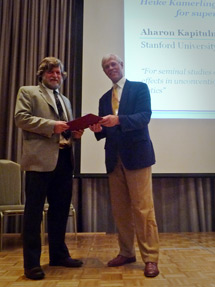
Handy Links
SLAC News Center
SLAC Today
- Subscribe
- Archives: Feb 2006-May 20, 2011
- Archives: May 23, 2011 and later
- Submit Feedback or Story Ideas
- About SLAC Today
SLAC News
Lab News
- Interactions
- Lightsources.org
- ILC NewsLine
- Int'l Science Grid This Week
- Fermilab Today
- Berkeley Lab News
- @brookhaven TODAY
- DOE Pulse
- CERN Courier
- DESY inForm
- US / LHC
SLAC Links
- Emergency
- Safety
- Policy Repository
- Site Entry Form

- Site Maps
- M & O Review
- Computing Status & Calendar
- SLAC Colloquium
- SLACspeak
- SLACspace
- SLAC Logo
- Café Menu
- Flea Market
- Web E-mail
- Marguerite Shuttle
- Discount Commuter Passes
-
Award Reporting Form
- SPIRES
- SciDoc
- Activity Groups
- Library
Stanford
Around the Bay
Aharon Kapitulnik Awarded 2009 Heike Kamerlingh Onnes Prize
Stanford and SLAC physicist Aharon Kapitulnik received the 2009 Heike Kamerlingh Onnes Prize for Outstanding Superconductivity Experiments Wednesday at the Ninth International Conference on Materials and Mechanisms of Superconductivity in Tokyo.
Kapitulnik, who is chair of the Stanford Department of Applied Physics and a faculty member with the Stanford Institute for Materials and Energy Science, shared the prize with Brookhaven National Laboratory Physicists J.C. Seamus Davis and John Tranquada.
"[The Onnes] is one of the most eminent prizes in the field of superconductivity," said SIMES Director Zhi-Xun Shen. "The award recognizes the outstanding scientific contributions Aharon has made."
Kapitulnik received the prize for his work in identifying time-reversal symmetry-breaking effects in unconventional superconductors. Time reversal symmetry describes the invariance of quantum physical laws with a change in the direction of time. In contrast , a video of a baseball smashing through a window looks distinctly different played forward than it does when played in reverse—in other words, it breaks time reversal symmetry.
In superconductors, time-reversal symmetry can sometimes be found in the movement of electrons. For researchers, determining when time-reversal symmetry occurs—or in Kapitulnik's case, when it doesn't—can provide valuable insight into what gives a material superconducting properties.
"We classify materials and phenomena by their symmetry," Kapitulnik said. "Whenever you see some kind of symmetry that is broken, it means that something new happens. It helps classify types of superconductors and helps in looking for discriminating mechanisms of superconductivity."
To get a better idea of whether time-reversal symmetry breaking events occurred in materials of interest, Kapitulnik, working with Stanford physicist Martin Fejer, invented a device that would allow them to measure instances of broken time-reversal symmetry with greater precision than ever before. Using the apparatus, called the Sagnac interferometer, Kapitulnik was able to identify the effects in a variety of materials.
Kapitulnik is a Fellow of the American Physical Society and the Alfred P. Sloan Foundation. He received his doctorate from Tel Aviv University in 1983. He joined the Stanford faculty in 1985, after completing a postdoctoral fellowship with the Institute for Theoretical Physics in Santa Barbara. He has received numerous awards for his work, including the Presidential Young Investigator Award, the IBM Faculty Development Award and the TRW Faculty Assistantship Award. He was recently elected a fellow of the American Academy of Arts and Sciences.
—Nicholas Bock
SLAC Today, September 11, 2009
